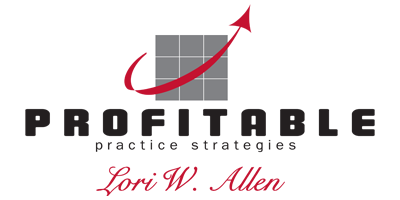By Lori W. Allen of Profitable Practice Strategies
Are You and Your Practice Ready for Integration?
Many of your colleagues have already moved in this direction, and with the constant change in insurance reimbursement, I recommend this as a viable option. Is it your time? If your answer is yes, there is a particularly important question you must ask yourself:
Have I built my practice with a solid foundation that can effectively support the additional services that will be introduced into the practice to deliver excellent patient care and outcomes?
The only answer must be yes. “I think so,” doesn’t fly here. It is exceedingly difficult to construct an addition on a house if the base is unstable. The same holds true in business. If the base is shaky, it will not successfully support any addition.
Let’s review the 6 Essential Components Necessary for a Successful Practice and see where your practice stands. Training CAs and clinical staff to provide the best patient outcomes and experiences has always been my focus and passion as a practice consultant.
Throughout the past 25 years, I have worked with hundreds of practices and discovered some undeniable truths. The most recognizable truth is that each and every office is unique. You have unique demographics, unique individuals providing care and customer service, and unique personalities. But, in light of this truth, I have also discovered many similarities. I have developed my 6 Essential Components Necessary for A Successful Practice to address the areas of importance that universally affect every practice.
1. Standardization of All Processes
The standardization of all processes applies to both administrative and clinical aspects of the office. Once processes and protocols are standardized, implemented, and managed, you have laid the groundwork for growth and success in the practice. These processes should follow a step-by-step protocol to ensure that the goal is accomplished. Administrative processes include phone scripting, prescheduling, recall/rescheduling, reactivation, the Business Report of Findings, and Financial Reviews. Clinical processes include consultation and new patient protocols, the Clinical Report of Findings, re-exams, rehab protocol, DME processes, and transitioning the patient to maintenance care.
2. Effective Communication
We communicate with others for the better part of every day, but we rarely focus on the quality of our interactions until there is a misunderstanding. To master the art of communication, you must work diligently and practice awareness in every interaction. In a successful interaction, you maintain open body language, comfortable eye contact, and engage in open questions and active listening.
Proactive and Not Reactive
Proactivity in communication, rather than reactivity, is the anticipation of needs and situations with the focus on solutions rather than putting out fires. Being prepared will facilitate a smoother flow in open communication, ensuring that your message is received with more clarity and enabling you to guide and lead the patient through the treatment process. When you are proactive, you control the scheduling and the rhythm of the practice rather than letting the patients dictate the flow.
Open Questions, Not Closed Questions
Open questions lead to stories and descriptions and are the heart of communication. Avoid phrases like “Do you want to schedule?” or, “Does that work for you?” These are clearly closed questions that provide you with a “yes” or “no” answer. Instead, guide and lead the patient by saying: “The doctor has prescribed a three-day-a-week treatment plan for you. What three days work best for you?” Follow up with: “Do you prefer morning or afternoon?” Do not ask the patient any further questions. Your interaction with the patient should be well-scripted, and clear and free of communication-blocking snags to facilitate open and unrestricted communication.
Be Assertive, Not Passive or Aggressive
Being assertive means that you can express what you think, feel, and believe and talk about yourself comfortably, no matter who the company is. Assertiveness is about owning your thoughts and opinions and taking responsibility for your words and actions. It is about respecting yourself and others and expecting others to treat you with respect in return, holding them accountable when they don’t. In the office, being assertive requires you to take control of each situation through guiding and leading the patient. For example, you do not let the patient dictate their schedule—you lay out options for the patient and control the situation in a measured and confident manner.
Practice Active Listening, Not Just Hearing
One of the most crucial elements of conversation has nothing to do with speaking. The art of active listening is essential in two-way communication. When someone starts talking to you, it is an invitation to engage, and you need to stop what you are doing and actively participate. Face the person, make eye contact, and listen to the message and meaning they are trying to convey.
3. Accountability
Accountability is the willingness to claim 100% ownership for the results produced as a consequence of your involvement, both individually and collectively, with others in your workplace. This breaks down into personal accountability, team accountability, and managerial accountability. When all is in place, then the network of accountability is created. Personal accountability means holding yourself responsible for achieving your goals, completing your job duties, and following through on your commitments. For the practice to run cohesively, all members of the team must hold each other accountable for job performance and meeting of goals. In management roles, it means holding those you manage responsible for achieving goals, completing job duties, and following through on commitments. Holding yourself and others accountable can only be done when:
- Specifically identified objectives are set and communicated
- Job definitions are clearly defined and communicated
- Standards and systems are in place to measure goals and objectives
- Regular staff meetings are held, following an agenda
- Successes are acknowledged, as well as failures
4. Statistical Tracking & Analysis
Statistical tracking and analysis is the act of recording and reviewing your practice’s activities. At the very least, you should be tracking:
- Consultations
- New Patients
- Prescheduled Appointments
- Total Visits
- Missed Appointments
- Rescheduled Appointments
- Reactivated Patients
- Services
- Collections
Stats need to be tracked and analyzed. Both management and staff must be aware of individual and team statistics so everyone understands how to maintain or improve to reach goals. Stats should be posted prominently in the office where all staff members can see, such as a breakroom or meeting room. At your weekly staff meeting, statistics should be shared and discussed. This is the time to develop an action plan to improve down statistics and maintain up statistics.
5. A Strong Team With a Positive Attitude
To grow and support team culture and mentality, the practice must:
- Foster effective communication
- Set clearly defined plans and goals
- Define job descriptions and objectives
- Hold weekly staff meetings and daily huddles
- Acknowledge successes as well as failures
- Promote positive reinforcement
- Use rewards and motivation
Team building allows us to:
- Improve communication
- Work toward common goals
- Foster healthy competition
- Strengthen relations
- Break down barriers & reduce conflicts
- Improve problem-solving skills
- Recognize & appreciate individual contributions
- Get to know each other better
- Identify & capitalize on each individual’s strengths
- Create a motivating & enjoyable environment
- Have fun!
6. Proactive Marketing
Successful practices do not stop at the front door of the office. If you’re not proactively marketing services to current, past, and potential new patients, your growth will be slow and unpredictable. To maintain steady growth and profitability, a solid marketing plan needs to be in place to maximize revenue opportunities. All staff must be of the growth and expansion mindset; marketing is not an island by itself. The plan for marketing your practice should include:
- Patient referrals
- Social media
- Reactivation
- Patient appreciation
- Community and corporate outreach
- Surveying and lead generation
- Testimonials/Reviews
- Internal events (holiday celebrations, charity affiliations)
Remember, the best source for a new patient is an existing or past patient. These marketing programs give you access to a wealth of new patients, but only if everyone in the practice is focused on growth and expansion. Through the implementation of these 6 Essential Components, you have the keys to:
- Increase your volume
- Improve your retention
- Reduce your turnover
- Improve your efficiency
- Grow your practice
- Maximize your revenue
- Align your practice for integration
…and in turn solidify your base.
So…have you built your practice with a solid foundation that can effectively support the additional services that will be introduced into your practice to deliver excellent patient care and outcomes?

ABOUT THE AUTHOR:
Lori W. Allen is a practice integration specialist who heads Profitable Practice Strategies, a full-service healthcare consulting firm that improves the operational foundation of practices nationwide.
Hear from Lori as she presents during a General Session on May 3–4 at the upcoming 2024 ANJC Annual Conference! REGISTER TO ATTEND



0 Comments